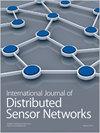TEZEM: A new energy-efficient routing protocol for next-generation wireless sensor networks
IF 2.5
4区 计算机科学
Q3 COMPUTER SCIENCE, INFORMATION SYSTEMS
International Journal of Distributed Sensor Networks
Pub Date : 2022-06-01
DOI:10.1177/15501329221107246
引用次数: 6
Abstract
The design and implementation of energy-efficient routing protocols for next-generation wireless sensor networks is always a challenge due to limited power resource capabilities. Hierarchical (clustering) routing protocols appeared to be a remarkable solution for extending the lifetime of wireless sensor networks, particularly in application-aware (threshold-sensitive) and heterogeneity-aware cluster-based routing protocols. In this article, we propose a protocol, namely, Threshold-based Energy-aware Zonal Efficiency Measuring hierarchical routing protocol. It is a heterogeneity-aware and threshold-based protocol that provides a better solution to existing problems in next-generation wireless sensor networks. During execution, the Threshold-based Energy-aware Zonal Efficiency Measuring hierarchical routing protocol splits the entire network area into several zones to manage network traffic efficiently. In the first step, Threshold-based Energy-aware Zonal Efficiency Measuring hierarchical routing protocol is designed for a homogeneous network where the initial energy of all the nodes is the same. Thereafter, we bring in heterogeneity in the Threshold-based Energy-aware Zonal Efficiency Measuring hierarchical routing protocol execution environment to optimize its energy consumption. By investigating the performance of the various numbers of divisions, it is proved that the Threshold-based Energy-aware Zonal Efficiency Measuring hierarchical routing protocol with 9 zonal divisions has higher stability and throughput. The performance of the proposed Threshold-based Energy-aware Zonal Efficiency Measuring hierarchical routing protocol is compared with those of Stable Election Protocol, Low-Energy Adaptive Clustering Hierarchy, Modified Low-Energy Adaptive Clustering Hierarchy, and Gateway-Based Energy-Efficient Routing Protocol through computer simulations. Simulation results verify the improved performance of the proposed Threshold-based Energy-aware Zonal Efficiency Measuring hierarchical routing protocol in terms of network stability, lifetime, and throughput.TEZEM:用于下一代无线传感器网络的新型节能路由协议
由于功率资源能力有限,下一代无线传感器网络的节能路由协议的设计和实现始终是一个挑战。分层(集群)路由协议似乎是延长无线传感器网络寿命的一个显著解决方案,特别是在应用感知(阈值敏感)和异构感知的基于集群的路由协议中。在本文中,我们提出了一种协议,即基于阈值的能量感知区域效率测量分层路由协议。它是一种异构感知和基于阈值的协议,为下一代无线传感器网络中的现有问题提供了更好的解决方案。在执行过程中,基于阈值的能量感知区域效率测量分层路由协议将整个网络区域划分为几个区域,以有效地管理网络流量。在第一步中,针对所有节点的初始能量相同的同构网络,设计了基于阈值的能量感知区域效率测量分层路由协议。然后,我们在基于阈值的能量感知区域效率测量分层路由协议执行环境中引入异构性,以优化其能耗。通过研究不同分区数的性能,证明了基于阈值的能量感知分区效率测量分层路由协议具有更高的稳定性和吞吐量。通过计算机仿真,将所提出的基于阈值的能量感知区域效率测量分层路由协议的性能与稳定选择协议、低能量自适应聚类层次结构、改进的低能量自适应集群层次结构和基于网关的能量高效路由协议进行了比较。仿真结果验证了所提出的基于阈值的能量感知区域效率测量分层路由协议在网络稳定性、寿命和吞吐量方面的改进性能。
本文章由计算机程序翻译,如有差异,请以英文原文为准。
求助全文
约1分钟内获得全文
求助全文
来源期刊
CiteScore
6.50
自引率
4.30%
发文量
94
审稿时长
3.6 months
期刊介绍:
International Journal of Distributed Sensor Networks (IJDSN) is a JCR ranked, peer-reviewed, open access journal that focuses on applied research and applications of sensor networks. The goal of this journal is to provide a forum for the publication of important research contributions in developing high performance computing solutions to problems arising from the complexities of these sensor network systems. Articles highlight advances in uses of sensor network systems for solving computational tasks in manufacturing, engineering and environmental systems.

 求助内容:
求助内容: 应助结果提醒方式:
应助结果提醒方式:


